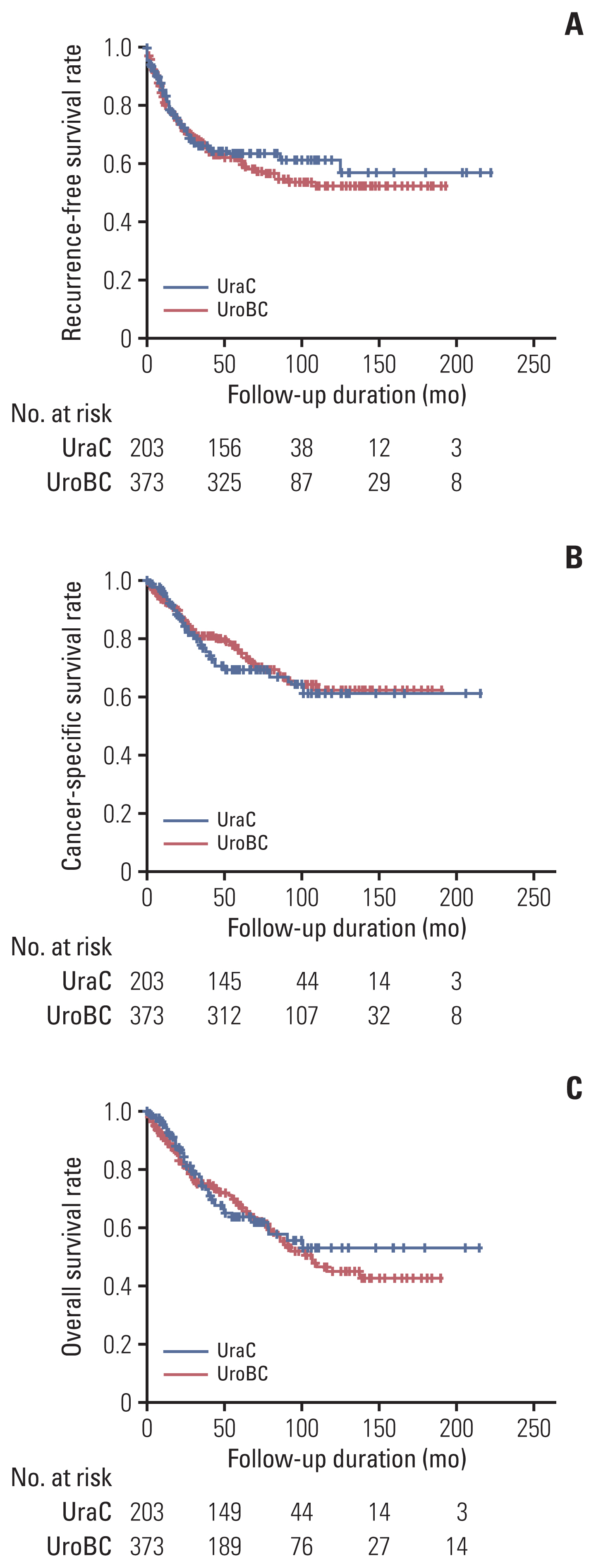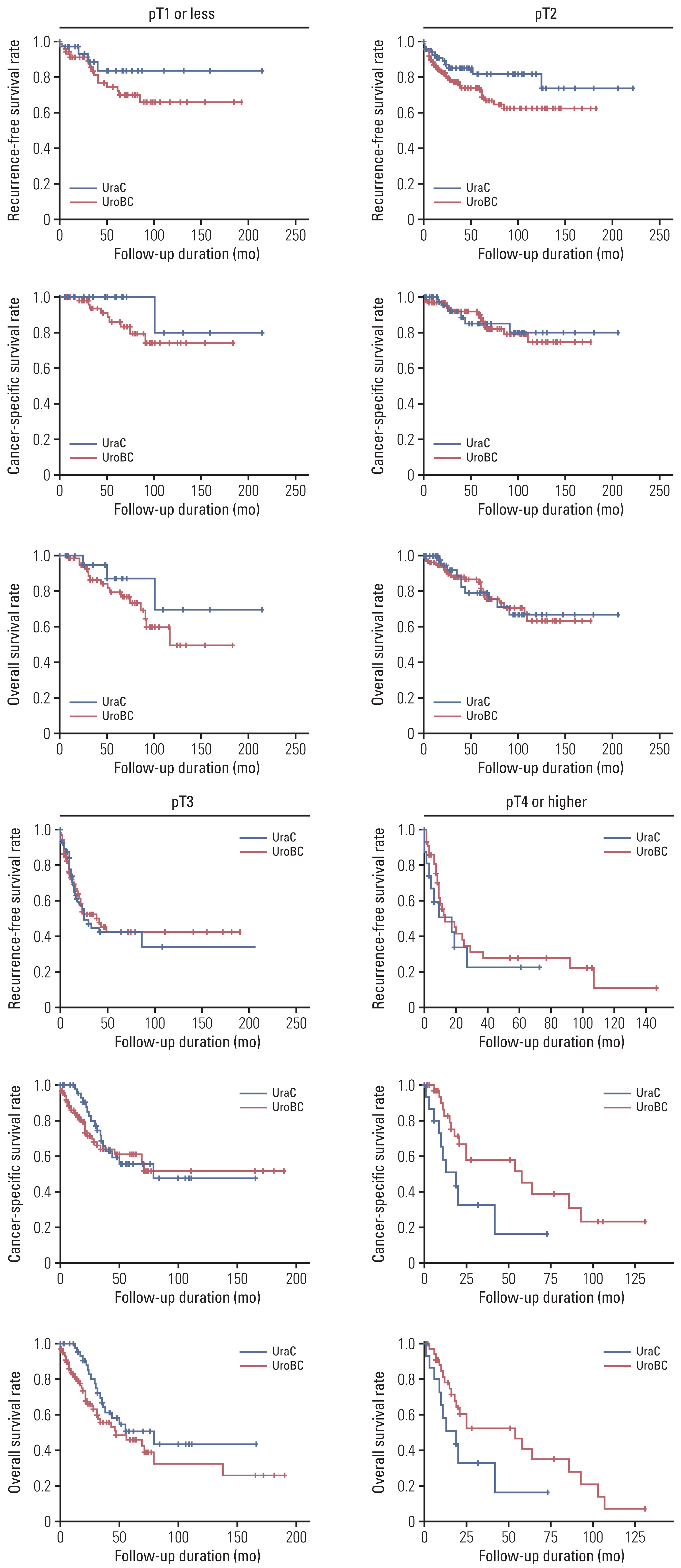Cancer Res Treat.
2023 Oct;55(4):1337-1345. 10.4143/crt.2023.417.
TNM-Based Head-to-Head Comparison of Urachal Carcinoma and Urothelial Bladder Cancer: Stage-Matched Analysis of a Large Multicenter National Cohort
- Affiliations
-
- 1Department of Urology, Seoul National University Bundang Hospital, Seoul National University College of Medicine, Seongnam, Korea
- 2Department of Urology, Seoul National University College of Medicine, Seoul, Korea
- 3Department of Urology, Yeungnam University Hospital, Daegu, Korea
- 4Department of Urology, Korea University College of Medicine, Seoul, Korea
- 5Department of Urology, Chonnam National University Medical School, Gwangju, Korea
- 6Department of Urology, Korea University School of Medicine, Seoul, Korea
- 7Department of Urology, Eulji University Hospital, Eulji University School of Medicine, Daejeon, Korea
- 8Department of Urology, Center for Urologic, National Cancer Center, Goyang, Korea
- 9Department of Urology, Myunggok Medical Research Institute, Konyang University College of Medicine, Daejeon, Korea
- 10Department of Urology, Samsung Medical Center, Sungkyunkwan University School of Medicine, Seoul, Korea
- 11Department of Urology, Kyungpook National University College of Medicine, Daegu, Korea
- 12Department of Urology, Chung-Ang University Hospital, Chung-Ang University College of Medicine, Seoul, Korea
- 13Department of Urology, Pusan National University Yangsan Hospital, Yangsan, Korea
- 14Department of Urology, Dongnam Institute of Radiological & Medical Sciences, Busan, Korea
- 15Department of Urology, Kangbuk Samsung Hospital, Sungkyunkwan University School of Medicine, Seoul, Korea
- 16Department of Urology, Severance Hospital, Urological Science Institute, Yonsei University College of Medicine, Seoul, Korea
- 17Department of Urology, Hanyang University Hospital, Seoul, Korea
- 18Department of Urology, Chungbuk National University Hospital, Chungbuk National University College of Medicine, Cheongju, Korea
- 19Department of Urology, Seoul St. Mary's Hospital, Seoul, Korea
- KMID: 2547807
- DOI: http://doi.org/10.4143/crt.2023.417
Abstract
- Purpose
Outcome analysis of urachal cancer (UraC) is limited due to the scarcity of cases and different staging methods compared to urothelial bladder cancer (UroBC). We attempted to assess survival outcomes of UraC and compare to UroBC after stage-matched analyses.
Materials and Methods
Total 203 UraC patients from a multicenter database and 373 UroBC patients in single institution from 2000 to 2018 were enrolled (median follow-up, 32 months). Sheldon stage conversion to corresponding TNM staging for UraC was conducted for head-to-head comparison to UroBC. Perioperative clinical variables and pathological results were recorded. Stage-matched analyses for survival by stage were conducted.
Results
UraC patients were younger (mean age, 54 vs. 67 years; p < 0.001), with 163 patients (80.3%) receiving partial cystectomy and 23 patients (11.3%) radical cystectomy. UraC was more likely to harbor ≥ pT3a tumors (78.8% vs. 41.8%). While 5-year recurrence-free survival, cancer-specific survival (CSS) and overall survival were comparable between two groups (63.4%, 67%, and 62.1% in UraC and 61.5%, 75.9%, and 67.8% in UroBC, respectively), generally favorable prognosis for UraC in lower stages (pT1-2) but unfavorable outcomes in higher stages (pT4) compared to UroBC was observed, although only 5-year CSS in ≥ pT4 showed statistical significance (p=0.028). Body mass index (hazard ratio [HR], 0.929), diabetes mellitus (HR, 1.921), pathologic T category (HR, 3.846), and lymphovascular invasion (HR, 1.993) were predictors of CSS for all patients.
Conclusion
Despite differing histology, UraC has comparable prognosis to UroBC with relatively favorable outcome in low stages but worse prognosis in higher stages. The presented system may be useful for future grading and risk stratification of UraC.
Keyword
Figure
Reference
-
References
1. Paner GP, McKenney JK, Barkan GA, Yao JL, Frankel WL, Sebo TJ, et al. Immunohistochemical analysis in a morphologic spectrum of urachal epithelial neoplasms: diagnostic implications and pitfalls. Am J Surg Pathol. 2011; 35:787–98.2. Bruins HM, Visser O, Ploeg M, Hulsbergen-van de Kaa CA, Kiemeney LA, Witjes JA. The clinical epidemiology of urachal carcinoma: results of a large, population based study. J Urol. 2012; 188:1102–7.3. Szarvas T, Modos O, Niedworok C, Reis H, Szendroi A, Szasz MA, et al. Clinical, prognostic, and therapeutic aspects of urachal carcinoma: a comprehensive review with meta-analysis of 1,010 cases. Urol Oncol. 2016; 34:388–98.4. Wright JL, Porter MP, Li CI, Lange PH, Lin DW. Differences in survival among patients with urachal and nonurachal adenocarcinomas of the bladder. Cancer. 2006; 107:721–8.5. Cho SY, Moon KC, Park JH, Kwak C, Kim HH, Ku JH. Outcomes of Korean patients with clinically localized urachal or non-urachal adenocarcinoma of the bladder. Urol Oncol. 2013; 31:24–31.6. Luzzago S, Palumbo C, Rosiello G, Pecoraro A, Deuker M, Mistretta FA, et al. Survival of contemporary patients with non-metastatic urachal vs. non-urachal adenocarcinoma of the urinary bladder. World J Urol. 2020; 38:2819–26.7. Wang T, Lv Z, Feng H, Li J, Cui B, Yang Y, et al. Survival of patients with UrAC and primary BAC and urothelial carcinoma with glandular differentiation. Front Oncol. 2022; 12:860133.8. Sheldon CA, Clayman RV, Gonzalez R, Williams RD, Fraley EE. Malignant urachal lesions. J Urol. 1984; 131:1–8.9. Ashley RA, Inman BA, Sebo TJ, Leibovich BC, Blute ML, Kwon ED, et al. Urachal carcinoma: clinicopathologic features and long-term outcomes of an aggressive malignancy. Cancer. 2006; 107:712–20.10. Hamilou Z, North S, Canil C, Wood L, Hotte S, Sridhar SS, et al. Management of urachal cancer: a consensus statement by the Canadian Urological Association and Genitourinary Medical Oncologists of Canada. Can Urol Assoc J. 2020; 14:E57–64.11. Kakizoe T, Matsumoto K, Andoh M, Nishio Y, Kishi K. Adenocarcinoma of urachus: report of 7 cases and review of literature. Urology. 1983; 21:360–6.12. Henly DR, Farrow GM, Zincke H. Urachal cancer: role of conservative surgery. Urology. 1993; 42:635–9.13. Molina JR, Quevedo JF, Furth AF, Richardson RL, Zincke H, Burch PA. Predictors of survival from urachal cancer: a Mayo Clinic study of 49 cases. Cancer. 2007; 110:2434–40.14. Behrendt MA, DEJ J, VANR BW. Urachal cancer: contemporary review of the pathological, surgical, and prognostic aspects of this rare disease. Minerva Urol Nefrol. 2016; 68:172–84.15. Claps M, Stellato M, Zattarin E, Mennitto A, Sepe P, Guadalupi V, et al. Current understanding of urachal adenocarcinoma and management strategy. Curr Oncol Rep. 2020; 22:9.16. Jia Z, Chang X, Li X, Wang B, Zhang X. Urachal carcinoma: are lymphadenectomy and umbilectomy necessary? Med Sci Monit. 2020; 26:e927913.17. Karl A, Carroll PR, Gschwend JE, Knuchel R, Montorsi F, Stief CG, et al. The impact of lymphadenectomy and lymph node metastasis on the outcomes of radical cystectomy for bladder cancer. Eur Urol. 2009; 55:826–35.18. Duan F, Zhai W, Zhang B, Guo S. Urachal carcinoma: Impact of recurrence pattern and lymphadenectomy on long-term outcomes. Cancer Med. 2020; 9:4166–74.19. Grignon DJ, Ro JY, Ayala AG, Johnson DE, Ordonez NG. Primary adenocarcinoma of the urinary bladder: a clinicopathologic analysis of 72 cases. Cancer. 1991; 67:2165–72.20. Dhillon J, Liang Y, Kamat AM, Siefker-Radtke A, Dinney CP, Czerniak B, et al. Urachal carcinoma: a pathologic and clinical study of 46 cases. Hum Pathol. 2015; 46:1808–14.
- Full Text Links
- Actions
-
Cited
- CITED
-
- Close
- Share
- Similar articles
-
- Synchronous Urothelial Carcinoma of the Bladder and Urachal Adenoma with Subsequent Malignant Transformation
- Adenocarcinoma of the urinary bladder: CT features
- Sigmoid-Urachal-Vesical Fistula Associated with Urothelial Carcinoma in an Adult Male: Case Report
- Mitotic Indices and Prognosis of Advanced Bladder Cancer
- Adenocarcinoma of the Urinary Bladder: Report of Three Cases



